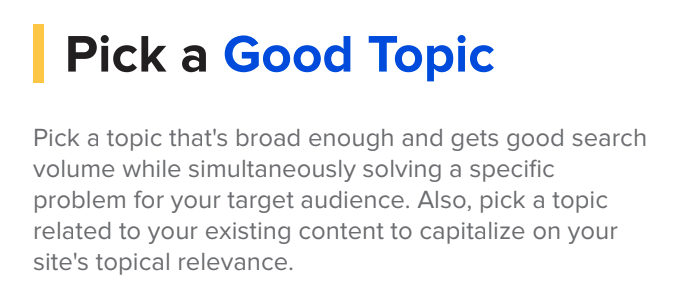Running a Successful Content Marketing Blog: Examples and Insights
If you’re pondering, “What are examples of content marketing?” the first thing that comes to mind is often a blog. Since the personal web pages and online journals of the early 1990’s, blogs have been web-defining content for many users. Visiting a blog is a way for readers to get information, perspective, and entertainment. Even when blogs are part of a marketing strategy, this history and purpose must be kept in mind. The purpose of a content marketing isn’t to make a hard sell, but instead to share information and ideas that readers can walk away with and share with others.
From more high-level insights on the purpose of a blog in a content marketing strategy, to lists of ideas for popular blog topics, let’s explore what new bloggers and established companies alike need to know about running an effective content marketing blog in the 2020s.
Blogs in a Content Marketing Strategy
52% of marketers agree that blogging is the most important content marketing strategy tactic. There are several reasons for this importance. The first is that blogs drive traffic to your website from multiple sources. When shared and promoted on social media, blogs capture the attention of your audiences on those networks and sends them to your website instead. Blogs also capture search engine traffic when keywords are prioritized in titles and headlines. In fact, blogs provide 3-4 times more leads through search engines than paid ads.
Blogs perform better than ads on search engines because they are made up of content audiences want and feel confident in trusting. This leads us to the second benefit of a blog as a content marketing example: the opportunity for your brand values to be put on display. Since blogs are longer content written to share information or subject-matter expertise, they also provide an opportunity to shed a light on the way you do business.
For instance, say you’re a software provider for hospitals. You want to write a blog about recent new regulations in the industry and make predictions about their impact. This isn’t just a chance to create a bulleted list of what changes are coming down the pipeline for your customers, but also to explain your unique thinking about how to navigate and even benefit from the changes. This blog post won’t just inform your readers about the changes in regulation but will also give them a glimpse of why your company would be a thoughtful and reliable vendor to work with during this time.
This brings us to the third point about the role of blogs in a content marketing strategy, which is the library of content they create on your website. The blog about the regulatory changes might not make a big splash on social media anymore once the laws are in place. But, the organic search benefit of the blog will still be working behind the scenes of your website to help you rank for keywords. And the values of your business that are on full display will still be there for discovery by potential customers as they do research on your company and get to know you.
While many have predicted the death of the blog due to the rise in popularity of video, the truth is that businesses of any size still benefit from leveraging regular blogging in their content strategies. Not only does this content perform better on search engines, it attracts reader attention and lets them get to know you at their own pace and on their own time.

Ready to create content but not sure where to start? We can help. DemandJump's content outlines are certain to get your content to rank. Get 4 FREE outlines on any topic or question important to you.

On What Topics Can I Write a Blog?
The question of what to write about on your company blog is one of the reasons lots of blogs end up being infrequently updated. While you might just want to wait for relevant news to strike and share company updates, this information isn’t exactly what your audiences need as they look for goods and services like yours. While information about your company like awards, recognition, mergers, and so on is definitely one category of blog topics, businesses can and should post blogs about a lot more.

Turning to the web to look for popular topics in 2020 reveals that blogging is still by and large a personal form of marketing. Tech blogs, personal finance, health and wellness, and personal development were the most popular blog topics of 2019. While your business might not exactly align with any of these interests, it’s still possible to pivot your perspective and consider how your unique audiences might have these needs, too.
To return to our example of the blog about new healthcare industry regulations, maybe your readers will be curious about new technology to help keep them in compliance or be concerned about the costs to keep up with new mandates. While these aren’t exactly tech blogs or personal finance, they do align enough with those verticals to make them good blog topics. You can write one post about technology and the new mandates. Another post about budgeting for upgrades could follow close behind. Different readers will be attracted to each one.

When it comes to popular blog topics, there are some key types of value readers are looking for in a blog. Regardless of the social media channel or other source where they find your content, there are some common unifiers defining a good blog post in the eyes of audiences. Here are generally what are the most profitable topics that generate traffic and eventual sales:
- Practical Blog Content like how-to guides, reports on the latest statistics and research, or lists of common mistakes and how to avoid them.
- Inspirational Blog Content like telling the story of how you overcame a problem, a spotlight on a key member of your team, or an analysis of the future of your industry.
- Funny Blog Content like a list of do’s and don’ts, a tongue-in-cheek story of a failure and your recovery, or a quiz that helps readers learn about themselves.
Ultimately, audiences for your blog want to be educated, want to be inspired, and want to be entertained. If your blog post can meet one or more of these criteria, it’s a topic worth exploring.
Small Business Content Marketing Examples Using Blogs
Let’s explore a few content marketing examples to show how small businesses can use blogs to improve their market presence and gain more customers. While these stories are hypothetical, they’re based on real-world examples, and the outcomes are possible for anyone.
Small Business Content Marketing Example 1: Appeal to Shared Interests
- The Strategy: The owner of a small graphic design agency decided to start a blog for the company. Rather than blogging about graphic design, she decided that she and her staff would write about general-interest topics that they cared about and knew audiences would too. Then, they would showcase the company’s design prowess through infographics and images in the blog.
- The Story: A long blog post about the importance of taking dogs on walks ended up going viral on Facebook with over 20,000 shares. This was especially thanks to the infographic images that helped readers share key information from the article.
- Why It Worked: This blog provided both practical advice and entertainment value to the reader. The cute design elements created by the business are part of what drives the enjoyment and share-ability of the blog. This appeal will cause them to be remembered when readers might want a designer in the future. Through keyword optimization on the images, the site has even been able to gain more organic search ranking thanks to the web traffic.
Small Business Content Marketing Example 2: Predictions That Inspire
- The Strategy: A director of marketing at a small accounting company got tired of seeing competitors' blog posts reach top search ranking while their own stayed on the second page. After doing some research, he decided to increase the rate blogs were being published to three times a week. However, he also noticed that competitor blogs were very negatively-focused, using fear to get clicks. He decided that the new blogs, posted more often, would also be more inspiring.
- The Story: On a day where market downturn in the news had many competitors posting gloom-and-doom analysis, this company’s positive spin on tips and advice led to many peers in the industry praising their insight and perspective. Their blog article caught the attention of a leading accounting industry magazine, where they have now been invited to share a monthly column of positive spin on events.
- Why It Worked: The accounting firm knew that they needed to comment on the news of the day but didn’t follow along with the same perspective as their competitors. Instead, they used subject matter expertise to meet their audiences’ emotional needs for hope, and the commentary paid off. Plus, the increased frequency of blogs meant new readers and followers had a reason to keep checking the website often.
Small Business Content Marketing Example 3: Localize Your Impact
- The Strategy: The owner of a small local coffee shop found themselves looking for options to compete after a popular chain opened up the street. Knowing they had to compete against the chain’s nationwide market dominance, they decided to leverage email marketing and social media to increase brand loyalty and attract new local customers.
- The Story: The shop owner decided to start writing a weekly blog about elements of the city culture and history of local landmarks. They also started doing profiles and features of the local artists and musicians that performed and displayed art in the café. Though no one specific post was responsible, over the course of a year they grew to have over 10,000 social media followers and profits doubled.
- Why It Worked: Rather than trying to compete with the nationwide chain on its terms, the small business owner focused on their shared values with the audience—a love of community and the arts. Not only did the blog strategy make them a trusted resource about the goings-on around town, it also upped their organic search ranking for coffee shops and performance venues in their city specifically.
These anecdotes don’t just reveal how blogging in particular is a key part of content marketing, but also how the content marketing strategy as a whole must function to drive success through the blog.
Content Marketing on Social Media: Promoting Blogs
When it comes to promoting blogs on social media, there are a spectrum of approaches a business can take. The simplest is writing a social media post and sharing a link to the article. This is a basic but powerful strategy. On Facebook, it can be backed up with a small paid boost to an audience you define. Whether you narrow the audience by shared interest, age range, location, job title, or all of the above, even a few dollars can get your blog post in front of far more people than just publishing it to your business page.
LinkedIn and Twitter also allow for paid boosting, but it can be more expensive and less precise. On those channels, using hashtags is a great way to focus the audience of your content. Perform a few searches on the platform first to find out which phrases or keywords will have the best appeal.
Joining groups on Facebook and LinkedIn is another way to share your content and promote your blog to people who you know are part of your target audience. Just make sure you know the community terms and won’t be harming your image by sharing your original content in the group—some groups don’t want that!
However, promoting your blog on social media shouldn’t always include a link to go read more right now. Social media works best when followers feel connected, engaged, and valued. Asking questions without posting a link, or sharing posts welcoming new followers, is a great way to keep people engaged with the idea of your blog.
Lastly, don’t be afraid to share old blogs over again when the topic becomes relevant. You might want to update the image and title to avoid looking too repetitive, but repurposing old content is just as valuable as writing something new.
Further Ways to Promote Your Blog
Social media is a great way to drive direct traffic to your blog, but it isn’t the only way. Here are some other methods to promote your business blog:
- Email Newsletter: If you’re able to build an email subscriber list, sending out your content in a monthly or quarterly newsletter is a great way to get the attention of past and present customers who might not follow you on social media. It’s a great way to stay top-of-mind.
- Retargeting: Also known as remarketing, this is a practice that sets a cookie in the user’s browser so they will be reminded to return to your website after they visit your blog the first time.
- Build Backlinks: Getting other websites to link to your blog is one way to drive traffic and improve search engine authority at the same time. By just writing quality content, you could get backlinked and cited as an authority, or you could reach out to other marketers and inquire about trading backlinks to cross-promote each other's content.
- Guest Post: In addition to backlinking, you can also write guest posts for other websites or blogs, with a mention of your blog at the end to send readers in your direction.
Promoting your blog isn’t just about attracting new readers, but also keeping your current followers interested in coming back over and over. Keeping your content fresh, insightful, and entertaining is the best strategy to make your blog succeed.
DemandJump: Tools to Generate a Blog Topics List and Blog Outlines
Blog audiences want to be informed, inspired, and entertained by the blog content they read. With so many options on our news feeds and in our email inboxes, this can be harder than it sounds to achieve. That’s why we’ve built in features to the DemandJump platform that take the legwork—and guesswork—out of blog topic generation and blog outlining.
The platform connects competitive research and customer behavior insights into one source. With the click of a button, users can see the questions audiences are asking, and examine the answers their competitors are providing. This lets you see exactly where your blog can fit into the conversation and capture traffic share immediately.
Then, the platform generates SEO content outlines for your chosen topic, letting you know the search terms you should prioritize and the questions you need to answer. From there, the creative part is all yours. Use DemandJump free for seven days and get a sense of just how easy maintaining your company blog could become.












